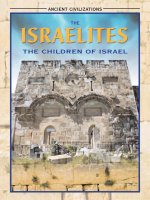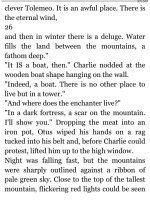the israelites the children of israel (ancient civilizations)
Bạn đang xem bản rút gọn của tài liệu. Xem và tải ngay bản đầy đủ của tài liệu tại đây (11.58 MB, 49 trang )
THE
ISRAELITES
THE CHILDREN OF ISRAEL
by
KATHERINE REECE
ANCIENT CIVILIZATIONS
www.rourkepublishing.com
© 2005 Rourke Publishing LLC
All rights reserved. No part of this book may be reproduced or utilized in any
form or by any means, electronic or mechanical, including photocopying,
recording, or by any information storage and retrieval without permission in
writing from the publisher.
www.rourkepublishing.com
PHOTO CREDITS:
Courtesy Charles Reasoner: pages 10, 11, 17;
Courtesy www.freestockphotos.com: pages 13, 18, 24, 25, 27, 31, 40, 42, 43;
Courtesy Dr. Carl Rasmussen, www.holylandphotos.org: page 35;
Courtesy NASA: page 7; Courtesy Rohm Padilla: pages 13, 23
DESIGN AND LAYOUT: ROHM PADILLA
Library of Congress Cataloging-in-Publication Data
Reece, Katherine E., 1955-
The Israelites : the lawgivers / Katherine Reece.
p. cm. (Ancient civilizations)
Includes bibliographical references and index.
ISBN 1-59515-239-3 (hardcover)
1. Jews History 1200-953 B.C Juvenile literature. 2.
Jews History 953-586 B.C Juvenile literature. I. Title. II. Series.
DS121.55.R44 2004
933 dc22
2004012113
TITLE PAGE IMAGE
Israelites praying at the sacred Wailing Wall in Jerusalem
www.rourkepublishing.com -
Post Office Box 643328 Vero Beach, Florida 32964
TABLE OF CONTENTS
INTRODUCTION … 4
Chapter I
WHO WERE THE ISRAELITES? … 6
Chapter II
THE UNITED MONARCHY … 14
Chapter III
WARS AND CONQUESTS … 20
Chapter IV
TRADE BY LAND AND SEA … 22
Chapter V
DAILY LIFE IN ANCIENT ISRAEL … 24
Chapter VI
WHAT DID THE ISRAELITES WEAR? … 28
Chapter VII
WHAT DID THE ISRAELITES EAT? … 31
Chapter VIII
RELIGION OF THE KINGDOM OF ISRAEL … 33
Chapter IX
THE PEOPLE TODAY … 38
A Timeline of the History of the Israelites … 44
Glossary … 46
Books of Interest … 47
Web Sites … 47
Index … 48
4
introduction
“Israel, Palestine, Jordan, the West Bank More conflict
in the Middle East!” We hear news stories like these almost
daily. Who are these people and why are they fighting? Israel
is a small country not much bigger than the state of Rhode
Island. How could such a tiny part of the world be the
center of so many conflicts? What is the conflict about? To
get an understanding of this part of the world we must take
a look at its history. More than 10,000 years ago, some of
the oldest known civilizations had their beginnings in this
A major source of conflict in Israel is the ownership of land. The property
below that houses the Wailing Wall and the Dome of the Rock is a holy site
to two cultures, and both have claims to it and other parts of Israel.
5
region. Whole cities, kings, and armies had come and gone
over this ancient landscape while people in North America
were still wearing animal skins and using stone tools. Yet
this tiny country, lying along the shores of the eastern
Mediterranean Sea, gave birth to so much of what we take
for granted in our thoughts and beliefs. Who hasn’t heard
the story of Noah and the Ark? Of Adam and Eve? These
stories and many others like them are woven into the fabric
of human history. Names we use today, such as David,
Jonathan, Joseph, and Rachel, come from a civilization that
is more than 5,000 years old!
Many popular stories such as the one that tells of Adam and Eve find their
origins in the history and religion of the Israelites.
6
The modern country of Israel was created in 1948, when
the United Nations divided ancient Palestine into Jewish
Israel and Arab Jordan. But Israel had its beginnings in a
region called Canaan in western Asia along the coast of the
Mediterranean Sea. As early as 3000 B.C.E., people known
as Canaanites were forming communities or city-states,
irrigating the land for crops, and settling in one place rather
than roaming in search of food and water. By 2000 B.C.E.
three major civilizations began to develop in the land of
Canaan. The first, Phoenicians, settled in the northern
section called Phoenicia. They became skilled navigators,
sailors, and traders and built a trading empire that reached
to distant lands. The second group, the “Hebrew People,”
later became the Israelites. They settled around 1200 B.C.E.
in the part of Canaan that later became known as Palestine.
The third group of seafaring people, named “Sea Peoples”
by Egyptians, drifted into an area that would become
known as Philistine along the coast south of Palestine.
These people, the Philistines, were often at war with
the Israelites.
WHO WERE
THE ISRAELITES?
CHAPTER I:
Palestine was at the center of
trade routes linking Asia Minor,
Egypt, present-day Syria, and
Mesopotamia. As a result,
Palestine was a meeting place for
the exchange of religious and
cultural ideas. Palestine is the
Holy Land described in the Bible.
7
DISPUTED
TERRITORY
Much of the
fighting in Israel
has been over
land ownership.
The area known
as ancient
Palestine consists
of the modern
countries of Israel
and Jordan.
This land has
been occupied
by various
civilizations, at
different times
throughout history.
Today, many
Palestinian Arabs
also have a claim
to the land and
want a country
of their own
called Palestine.
DEAD SEA
SEA OF GALILEE
CANAAN
PALESTINE
MEDITERRANEAN
SEA
A view of the location of the modern
country of Israel with its coast along the
Mediterranean Sea
ISRAEL
8
Our knowledge of the Israelites
comes from Egyptian writings, the
stories of the Bible, and archaeology.
From the earliest times, the story of
the Israelites is closely linked to the
promise of land by their god, Yahweh,
and the biblical stories of their travels.
The story of the Israelites begins with Abram, a shepherd
from the Sumerian city of Ur in Mesopotamia. Abram and
his people were nomads who carried their belongings and
trade goods on the backs of donkeys, while traveling from
city to city. They eventually settled on a fertile strip of land
bordering the Mediterranean Sea in the land of Canaan,
around 1950 B.C.E.
(Below left) much of what we know about ancient Israel comes from the
work of archaeologists. (Below right) a camel loaded with its owner’s
belongings has been a common way of travel since ancient times.
Abram leading his family
9
Abram had a son
named Isaac, which
means “laughter.”
Isaac’s second son and
Abram’s grandson was
named Jacob, and he
had 12 sons, after
which the 12 tribes of
Israel are named.
“EXALTED
FATHER”
Israelites believe
they are descended
from a shepherd
named Abram
(“exalted father”).
Abram said that
God directed him
to take his family
to the land of
Canaan. Abram’s
grandson, Jacob
(“the grabber”),
wrestled with an
angel and won. His
name was then
changed to Israel
(“striver with God”).
From his name
comes the name of
the country, Israel,
and its citizens,
the Israelites.
After wrestling with an angel Jacob’s name
was changed to Israel.
10
The youngest of these sons, Joseph, was sold by his
brothers into slavery in Egypt. Eventually he rose in power
and became second only to the Pharaoh in all of Egypt.
Drought and famine persisted in Canaan, and his brothers
looked for help in Egypt, where there was plenty of food
and land. Joseph forgave his brothers, and their families
relocated to Egypt. The “Children of Israel” probably lived
in the land of Egypt for several hundred years.
11
After many years, Ramses II, the Egyptian Pharaoh, began
to feel threatened by the growing population of Israelites.
To manage them, Ramses II forced the Israelites into slavery
and servitude. As a further attempt to control the Israelite
population, the Pharaoh ordered that all male children of
the Israelites be put to death.
This illustration is a reproduction of wall paintings taken from an Egyptian
tomb. It shows Canaanites being introduced into an Egyptian court as
Joseph's brothers may have been brought before him.
One child, named Moses, was
taken in by the Pharaoh’s daughter
and raised as a member of Ramses’
household. When he learned of his
true heritage as an Israelite, Moses
believed that he was to lead the
Israelites back to the Promised
Land in Canaan. After many years
under the leadership of Moses, the
Israelites came to rest at Mount
Sinai. It was at Mount Sinai that
Moses called on the Israelites to
make a covenant, or agreement,
with their god, Yahweh. In the
Biblical record, this is where the
Israelites received the Ten
Commandments, which was a
set of laws for religious and
moral behavior.
12
THE TEN
COMMANDMENTS
1. You shall have
no other gods
before me.
2. You shall make
no graven images.
3. You shall not
take the name of
the Lord your God
in vain.
4. Remember the
Sabbath day, to
keep it Holy.
5. Honor your
father and your
mother.
6. You shall not
murder.
7. You shall not
commit adultery.
8. You shall not
steal.
9. You shall not
testify falsely
against your
neighbor.
10. You shall not
covet anything
your neighbor has.
According to the Bible, Moses
received the Ten Commandments
at the top of Mt. Sinai.
13
After 40 years, the Israelites
finally crossed the Jordan River
and entered the land of Canaan.
There, the 12 Tribes of Israel
formed the Kingdom of Israel.
LAND OF
CANAAN
Most of the land
of Canaan, later
called Palestine,
was held by the
12 Tribes of Israel.
The names of the
tribes were Asher,
Benjamin, Dan,
Ephraim, Gad,
Issachar, Judah,
Manasseh,
Naphtali, Reuben,
Simeon, and
Zebulun.
Map showing the areas controlled by
each of the 12 Tribes of Israel
(Above) the Jordan River is a holy
river to more than one culture.
To regain the lands they had left behind during the time
of Abram, the returning Israelites fought the Philistines
who were then living there, for nearly 200 years. The first
governors of Israel were both judges and military leaders.
The Israelites demanded a king, but they did not want an
absolute monarch. They wanted their king to obey the laws
of the Torah and to be tried by a group called the sanhedrin
if the laws were broken. The sanhedrin was similar to
today’s supreme court of Israel. It was made up of 71
sages, or wise men,
who had received
semicha, or a holy
direction from God,
and knew the laws
of the Torah.
14
Israel was first governed by
judges or military leaders.
Saul was the first king of
Israel but it was not until
David came to power
that the 12 Tribes were
united under one ruler.
the united monarchy
CHAPTER II:
King David was a
shepherd boy who
killed the Philistine
known as Goliath. He gained
the favor of the king and
rose in power to become
one the most powerful of
Israel's kings.
15
Israel prospered under King Saul, the land’s first
king, and later under King David. David became
king in approximately 1004 B.C.E. and was able to
finally defeat the Philistines and unite the 12 Tribes of
Israel. He was able to expand his empire from the Sinai
Desert and Gulf of Aqaba into southern Syria. The Kingdom
of Israel became the strongest power between the Nile and
Euphrates rivers.
16
King David built a capital in Jerusalem after taking the city
from the Canaanites in 1000 B.C.E. The location of Jerusalem
was perfect, since it was not the home of any one tribe. The
Israelites believed Yahweh was present in Jerusalem, and the
city became the religious center for the Israelites. They also
believed that their king was the “Son of Yahweh.”
These photos are of the old city of Jerusalem. The Dome of the Rock is
present in both photos as well as one of the walls of the old city. The wall
surrounding ancient Jerusalem earned it the name “the Walled City.”
17
The Kingdom of Israel reached its greatest period of
wealth and peace under King David’s son, Solomon, who
ruled between 965 and 928 B.C.E. King Solomon divided
the kingdom into 12 districts and developed a system of
law. King Solomon is known for his wisdom and sense of
fairness, but he also introduced high taxes and forced men
to work on public projects such as palaces, fortresses, and
the Temple of Jerusalem.
The design and interior of the Temple of Jerusalem
HOLY OF
HOLIES
ARK OF
THE COVENANT
RAISED
PLATFORM
MAIN HALL
BRONZE
COLUMNS
18
The Temple of Jerusalem was not
large, but it was richly decorated.
The Ark of the Covenant was
housed here and guarded by two
winged sphinxes, or kerubim in
animal form. All religious festivals
were celebrated in the temple, and
animal sacrifices were offered there.
TEMPLE OF
JERUSALEM
AND ARK OF
THE COVENANT
The Temple of
Jerusalem was a
place of pilgrimage
and worship. It
stood as a fortified
enclosure with
many decorations
and furnishings.
Priests directed
music and worship.
Animal sacrifices
were made in the
temple. The Ten
Commandments,
as given to Moses,
were kept in the
Ark of the
Covenant within
the Temple.
A reproduction of the
Ark of the Covenant with angel forms
overlaid with gold
The Dome of the Rock sits on the same spot
where the Temple of Jerusalem once stood.
19
After Solomon’s death, the kingdom split into two sections–
Israel in the north and Judah in the south. Jeroboam, one of
Solomon’s early military leaders, was elected to rule Israel,
while Solomon’s son, Rehoboam, continued the dynasty of
King David in Judah. In addition to conflicts within the
Divided Kingdoms, the Israelites once again had fights with
neighboring empires. Although weakened by conflicts, Israel
began to regain its power in 786 B.C.E.
Solomon’s Pillars were the location of an ancient Egyptian copper mine.
They were named after the king because of his association with pillars such
as the ones that decorated the front of the temple.
20
The Assyrians invaded the land of
Canaan many times over the years and
demanded that their new territories
pay high taxes. By 721 B.C.E. the
Assyrians had captured Israel and
the northern kingdom, and 20 years
later they captured the southern
kingdom of Judah. Judah became a
vassal of the Egyptian empire in
609 B.C.E. and a tributary to
WARS AND CONQUESTS
CHAPTER III:
(Above) an Israelite archer in traditional military dress
(Below) the desert around the area of Judah, which came under
Assyrian rule for more than 100 years
21
Babylon in 597 B.C.E. Tiring of the constant rebellions, King
Nebuchadnezzar II of Babylonia captured and burned
Jerusalem in 586 B.C.E., and the Israelites were taken captive
as slaves and forced to live in Babylon. About 50 years later,
Cyrus the Great of Persia captured Babylon. He allowed the
Israelites to return home and rebuild their temple. Although
Israel was now a Persian province, the Israelites were finally
able to live once again in their homeland.
Etching of an Israelite family during the captivity in Babylon. Their
Babylonian master stands over them and appears to be issuing a command.
In ships built and manned by Phoenicians, King Solomon’s
Red Sea Fleet sailed every three years to Africa and Arabia.
After being gone for more than a year, the ships returned,
carrying gold, precious stones,
sandalwood for making harps and
lyres, spices, ivory, and even apes
and baboons to amuse the royalty.
TRADE BY LAND AND SEA
CHAPTER IV:
(Right) baboons were only one of many
exotic animals and products shipped
abroad on large ocean ships (above)
built by the Phoenicians.
22
23
Overland trade also grew and soon caravans were traveling
to Mesopotamia, Syria, and Egypt. Israel was centrally located
for the exchange of goods between countries. Palestine
bought chariots in Egypt and sold them to Hittites and
Aramaeans. Horses from Cilicia, which is now Turkey, were
exchanged far and wide.
Many goods were also shipped overland through Palestine by traveling
caravans. This merchandise traveled as far as Mesopotamia and Turkey.
Many trade
routes crossed
ancient Palestine
and spread
throughout the
Middle East and
Africa.
24
The Israelites in 1200 B.C.E.
worked hard and generally lived
modestly. Besides a few clay pots
for everyday use, they had few
items of luxury. Outside the
cities men worked as farmers,
fishermen, or carpenters.
Work days were long,
with both men and
women working 10
to 12 hours a day.
Women cooked, gathered wood and dung for fuel, while
caring for the children. A woman might be seen balancing a
bundle of brush five times her size on her head. By the age
of 13, children were expected to work long hours, and even
small children had their share of family chores. In this
desert environment, water was scarce and several trips a day
to the deeply dug wells were necessary to supply water for
the family and its livestock.
CHAPTER V:
DAILY LIFE IN
ANCIENT ISRAEL
An Israeli woman gathering greens into bags,
just one of many tasks in a long work day









